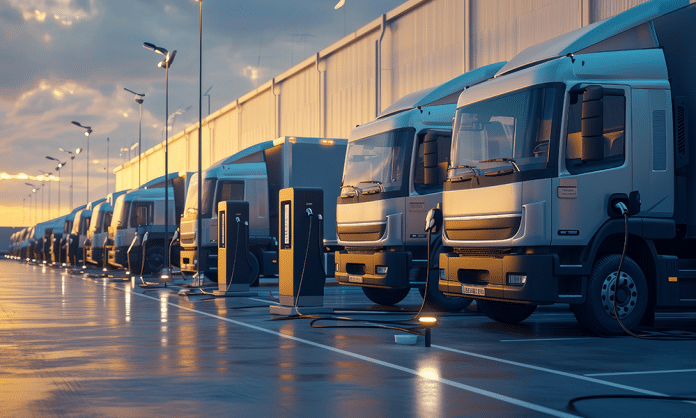As the world moves forward, the collective concern for the planet’s environmental health has sparked a more focussed discussion around the need for sustainable changes in transportation. With this in mind, and with the UK’s ban on diesel and petrol vehicle sales set for 2035, the haulage industry – and fleet management in general – stands at the cusp of a significant transformation. This article – penned by eHGV charging experts Electrassure – seeks to scratch the surface of eHGVs and get the ball rolling for companies looking to make the switch.
The Drive for Change in Transportation
The push towards sustainable practices is particularly poignant within the haulage industry, which has traditionally relied heavily on diesel-powered HGVs. Now, governments worldwide are legislating for a greener future, prompting businesses to reconsider their fleet compositions in favor of electric alternatives. Change of this scale can be complex, but it’s by no means impossible. The first step involves gaining an understanding of the vehicles in question.
Understanding Electric Heavy Goods Vehicles
Electric HGVs (eHGVs) mark a substantial shift towards greener transportation methods. Powered by rechargeable battery packs, these vehicles offer a cleaner alternative to their diesel counterparts, without compromising on the essential capabilities needed for long-haul and heavy goods transportation. The introduction of eHGVs into the market reflects a broader trend seen across the automotive industry, where electric vehicles (EVs) of various sizes and capacities are becoming increasingly prevalent.
Below, we explore some of the benefits of making the switch to an electric fleet.
Pros of Switching to Electric HGVs
Environmental Benefits
Zero Emissions: eHGVs significantly reduce the carbon footprint, offering a solution to improve air quality and contribute to environmental health.
Noise Reduction: Electric motors operate much quieter than diesel engines, reducing noise pollution.
Economic and Operational Advantages
Lower Running Costs: Electricity is cheaper than diesel, and eHGVs have fewer moving parts, leading to lower maintenance costs.
Government Incentives: Initiatives like the Plug-in Van Grant (PIVG) can offset initial purchase costs, making eHGVs more economically viable.
Corporate Responsibility
Adopting eHGVs enhances a company’s sustainability profile, aligning with CSR goals and appealing to eco-conscious customers.
Drawbacks of Switching to Electric HGVs
We’d like to keep this article balanced, and it would be unfair to list the positives of switching without also considering the potential drawbacks. It’s worth noting that the items listed below are all developing situations – the economy of eHGVs is in constant motion as the affordability and technology improves.
Initial Investment
Higher Purchase Price: At the moment, the upfront cost of eHGVs can be substantially higher than diesel HGVs, though this is mitigated by long-term savings and grants. Aside from this, the price of electric vehicles is likely to drop as they become more prevalent on the road.
Infrastructure Investment: Establishing a charging infrastructure requires a fair amount of initial investment and planning.
Operational Challenges
Range Limitations: Current eHGV models have a shorter range compared to diesel counterparts, which could impact long-distance haulage operations.
Charging Time: Recharging an eHGV takes longer than refueling a diesel HGV, potentially affecting operational efficiency.
Infrastructure and Support
Charging Network: The availability of charging stations suitable for HGVs is still developing, which could limit operational routes.
Technical Support: As eHGV technology is relatively new, finding service centers with the expertise for maintenance and repairs might be challenging.
Making A Decision
For fleet managers, weighing the pros and cons is a complex process that requires considering the long-term vision for their fleets, operational needs, and environmental commitments. Transitioning to eHGVs represents not just a financial decision but a strategic move towards sustainability.
Should you decide to transition, planning is key. There are a few options you can explore to help you get started.
Pilot Programs: Starting with a small number of eHGVs can help understand their impact on operations without committing the entire fleet.
Government and Manufacturer Support: Leverage available incentives and work closely with manufacturers for the best deals and support.
Infrastructure Planning: Collaborate with infrastructure providers to ensure charging stations are available where needed.
The Current State of eHGVs in the UK
The UK’s landscape for electric HGVs is gradually expanding, with several models already on the roads and more in development. Brands like Mercedes-Benz, Renault Trucks, and Tevva are leading the charge, offering vehicles designed for various operational needs. This growing availability, combined with government incentives like the Plug-in Van Grant (PIVG), is paving the way for a more sustainable haulage industry.
Implementing Electric HGVs into Business Operations
Integrating eHGVs into existing operations requires strategic planning, from establishing charging infrastructures to ensuring driver and maintenance personnel are well-versed in the new technology. Companies like ElectrAssure are emerging as pivotal partners in this transition, offering expertise in charge point implementation and management systems.
The Future of Electric HGVs
With ambitious global targets and technological advancements, the future of eHGVs looks promising. The industry’s move towards electric is not just a response to legislative demands but a proactive step towards sustainability. By 2040, new HGV sales must be zero emissions, marking a clear path for the industry’s evolution.
Conclusion
The transition towards electric HGVs embodies the broader shift towards sustainable transportation, offering businesses a unique opportunity to lead in this area. The environmental, economic, and social benefits of adopting eHGVs present an interesting case for businesses to consider – and one that could lead to a far greener future for businesses moving forward.
For more information click here.





